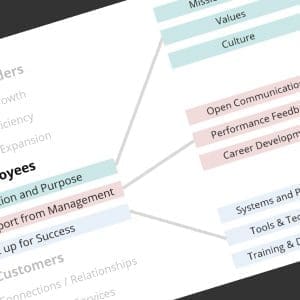Change is a natural part of the Digital Transformation process and nothing to worry about – as long as you don’t get too caught up in the drama of your Preferred Point of View.
I’m standing at the white board, leading a technical disagreement discussion about a particular data conversion component in a macro environment of sensors and data, hardware and software. This type of discussion pops up many times during the introduction and incorporation of innovations; we are debating definitions and abstract concepts, technical specifics, data volumes, vendor pedigrees. And we’re starting to burn time on the schedule – until someone steps back and notices how hard we’re arguing over a couple of amber boxes drawn on a whiteboard.
The sketch in question was a “conceptual architecture” for our smart, connected projects; an abstraction created solely to illustrate a point to a globally, technically, and motivationally diverse team, which will eventually serve as a building block for multiple Internet of Things products. A valuable document that aims to make our lives easier – so why all the angst?
Looking back, it would have helped to refocus on the objective; we are trying to get the whole team 1) agreed on problem definition, and 2) directionally aligned for problem solution. Fairly broad success criteria, and not so specific that it required a 20-page detailed tech spec with full budget and build plan. The conversation had shifted to a parsing contest (sic), where shades of meaning mixed with design and tech egos. Not so aggressive, more passive, but definitely hampered by the participants’ high confidence in what they knew, along with a comfortable assumption that the world outside their experience bubble carries little value.
Can we have a do-over? Of course – we are the makers of our own experience (and some damn fine products) – and this is classic change management stuff. An open discussion helps, a simple reminder that it’s not important to be Right in every debate …
- You may be wrong
- You may be blindered
- You may be unintelligible
Ah – that last one, by the way, is often the real issue. Communicating complexity, searching for concrete words for abstract ideas, explaining the innovative New to those deeply invested in the established Old – words can be terrifically tricky things.
So what does success look like? And what do we need to do? Back to the basics …
Victory #1 – Get the team on same page
- Be prepared to speak in words, pictures, stories, examples
- Make sure the team is not using similar words to mean different things
- Make sure the team is not using different words to mean similar things
Victory #2 – Get the team moving in the same direction
- Now that we’ve defined, discussed, and debated the As-Is and the To-Be – we focus on the Path to get there
- The first step specifics are important – but you don’t need the entire illuminated path to agree on the next step
- The team might disagree on the following step, even the final form of the To-Be; fine, that’s what you are probably working out in the next meeting
Change is rarely easy – some debate for hours the depth of their angst before getting started; others shift with the wind, grudgingly accepting a bit of backtracking near the end. But Change is a natural part of the process and nothing to worry about – as long as you don’t get too caught up in the drama of your Preferred Point of View.
7 March, 2016






Comments (0)